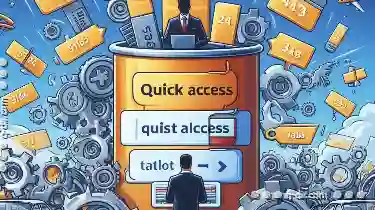Often taken for granted, this seemingly simple tool has managed to stay largely unchanged for decades-a stark contrast to the rapidly modernizing ...
 interfaces of other software types like graphical user interfaces (GUIs) and command-line interfaces (CLIs). This blog post delves into whether File Explorer could be considered the last bastion of non-programmable interfaces, exploring its historical context, current state, and future prospects. In the digital age, where software applications seem to evolve at light speed, it's easy to overlook the humble file explorer.
interfaces of other software types like graphical user interfaces (GUIs) and command-line interfaces (CLIs). This blog post delves into whether File Explorer could be considered the last bastion of non-programmable interfaces, exploring its historical context, current state, and future prospects. In the digital age, where software applications seem to evolve at light speed, it's easy to overlook the humble file explorer.1. The Evolutionary Stagnation of Interfaces: From Command Lines to Graphical User Interfaces
2. Current State: Features and Limitations of File Explorers
3. The Case for the Last Bastion: Why File Explorers Might Stay Non-Programmable
4. The Future: Blurring the Lines Between Programmable and Non-Programmable Interfaces
5. Conclusion: The Evolutionary Tug-of-War
1.) The Evolutionary Stagnation of Interfaces: From Command Lines to Graphical User Interfaces
The history of computing begins with command lines-a text-based interface where users typed commands to interact with the system. As technology advanced, interfaces evolved into graphical user interfaces (GUIs), which replaced text commands with visual elements like icons and windows. This shift was revolutionary, offering a more intuitive way for humans to communicate with machines.
However, while GUIs have become the norm in modern software applications, file explorers-tools designed specifically for navigating and managing files on a computer-have remained relatively unchanged since their inception. The lack of innovation in this area can be attributed to several factors:
- Complexity of File Systems: Modern operating systems manage complex hierarchical file structures that are difficult to simplify into user-friendly interfaces without compromising functionality.
- User Expectations: Users have grown accustomed to the traditional layout and features offered by file explorers, which makes them resistant to change unless there is a significant improvement in usability or efficiency.
- Proprietary Software Landscape: Many software developers focus on developing applications rather than investing time and resources into creating new interfaces for file exploration.
2.) Current State: Features and Limitations of File Explorers
Despite the lack of innovation, file explorers still serve a vital purpose in our digital lives. They provide basic functionalities such as navigating through directories, viewing files, and performing simple operations like copying, deleting, and renaming files. However, there are notable limitations to these tools:
- Limited Customization: While some advanced users may tweak settings or use third-party software for customization, the default functionality of file explorers is often limited by design considerations such as system stability and security protocols.
- Lack of Programmability: Unlike modern applications that offer APIs for developers to extend their features, file explorers are largely non-programmable interfaces. This lack makes it difficult for developers to create innovative tools or automate tasks directly through these interfaces.
3.) The Case for the Last Bastion: Why File Explorers Might Stay Non-Programmable
The argument that file explorers might be the last bastion of non-programmable interfaces can be supported by several points:
- System Integration: File explorers are deeply integrated into operating systems and system services, making it challenging to introduce programmability without disrupting these integrations.
- User Trust: Users trust the default functionality provided by file explorers for their data management needs. Introducing third-party software could lead to security concerns or user error due to unfamiliar interfaces.
- Technical Complexity: Developing a fully programmable interface for file exploration would require significant technical expertise and resources, which is not always available in the market.
4.) The Future: Blurring the Lines Between Programmable and Non-Programmable Interfaces
While file explorers may seem set in their ways, there are emerging trends that suggest a possible shift in paradigm:
- Cloud Storage Integration: As more users rely on cloud services for storage, file explorers might integrate these services directly, thereby introducing programmability through API integrations.
- User Education and Tools: Developers could create educational tools or plugins that extend the functionality of file explorers without altering the core interface itself.
- Open Source Contributions: Open source contributions can help in enhancing the capabilities of file explorers by adding features via third-party applications, thus blurring the lines between programmable and non-programmable interfaces.
5.) Conclusion: The Evolutionary Tug-of-War
In conclusion, while file explorers may currently be seen as the last bastion of non-programmable interfaces in software, future trends suggest a possible shift in this paradigm due to technological advancements and user demands. As technology continues to evolve at an unprecedented pace, it remains to be seen how deeply integrated programs like file explorers will adapt to these changes.
For now, users can continue to appreciate the simplicity and reliability of traditional file explorers while developers ponder over innovative ways to extend their capabilities without disrupting the basic user experience they have come to rely on.

The Autor: / 0 2025-06-11
Read also!
Page-

Is Tabbed File Management a Relic of a Bygone Era?
Where information overload is a constant challenge and productivity tools are constantly evolving, it's worth asking whether tabbed file management, ...read more

The Art of Crafting the Ultimate File Filter
Whether you are a graphic designer, a data analyst, or an IT specialist, having a robust file filtering system can make all the difference. This blog ...read more

The Cost of "Quick Access": Tab's Stagnant Progress.
One such technology is the tab interface - ubiquitous in applications from smartphones to tablets and desktop computers. Despite its widespread use, ...read more